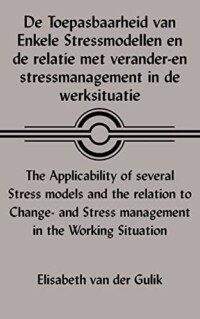Title: De Toepasbaarheid van Enkele Stressmodellen en de relatie met verander-en stressmanagement in de werksituatie… Stress Management in the Working Situation
Author: Elisabeth van der Gulik
Publisher: AuthorHouse
ISBN: 1420875663
ISBN: 1420875663
Language: English
Pages: 188 pages
Genre: Self-Help
Reviewed by: David Allen
Pacific Book Review
Elisabeth van der Gulik, who is a medical doctor in the Netherlands, Belgium, and France, shares her experiences, wisdom and research on stress as it manifests in different types of business organizations among variously challenged employees.
Her focus is on stress models, which have been proposed and which have found varying utility in the understanding, management and prevention of workplace stress. Van der Gulik’s monograph, based on a thorough acquaintance with the academic literature, and supported by excellent examples from her own consulting practice, identifies the following as significantly related to stress: lack of support for employees; lack of education for employees; level of work satisfaction; work conditions; level of remuneration; employee personality type; and faulty communication between departments at a business.
Real-life scenarios, including an I.T. corporation, a ‘green’ environmental services firm, a laboratory, and a health-care services company, fill out the author’s theory with hands-on palpable examples. In order to remediate stress-induced problems, the type of business organization must be identified, such as a matrix organization vs. a functional one.
Several times throughout the book van der Gulik cites the maxim, ‘A healthy organization is subject to change and to stress.’ Without (healthy) change, growth may be impossible – particularly in an age where competition, high employee turnover, and high product demand/output, are the norm.
Theory is augmented by specific recommendations. The writer, along with others in the management field, has found that resilient employees must know about the possibility of career movement, along with the possibility of further education. In order to be effective, the particular stress and organizational model should be specified; different types of organizations require different interventions to ensure quality and sufficient output. The overriding concern for management, and in this book, is the contrast between ‘rusted’ scenarios and those characterized by flexibility and creativity.
Work stress – singled out in the celebrated ‘general adaptation syndrome’ of Hans Selye – takes a number of forms. All too often workers call in sick. Physical illness frequently takes the form of cardiac complaints (up to and including heart attacks), insomnia, lassitude, and applications for leave and disability. Each of these confounds and obstructs the flow of business. Fortunately, the author and others in the field have identified feasible management and preventive techniques that can staunch the outflow of workers and reduce diminished productivity.
The present volume is bilingual, with the original Dutch monograph followed by an English translation. The book adds to our knowledge of workplace health, especially from an international perspective. In addition, it offers the unique viewpoint of the ‘workplace doctor’ and the optimism engendered by effective remedial and preventive techniques. It will be welcome reading for all levels of employees, managers and for those with interest in corporations and corporation policy.


